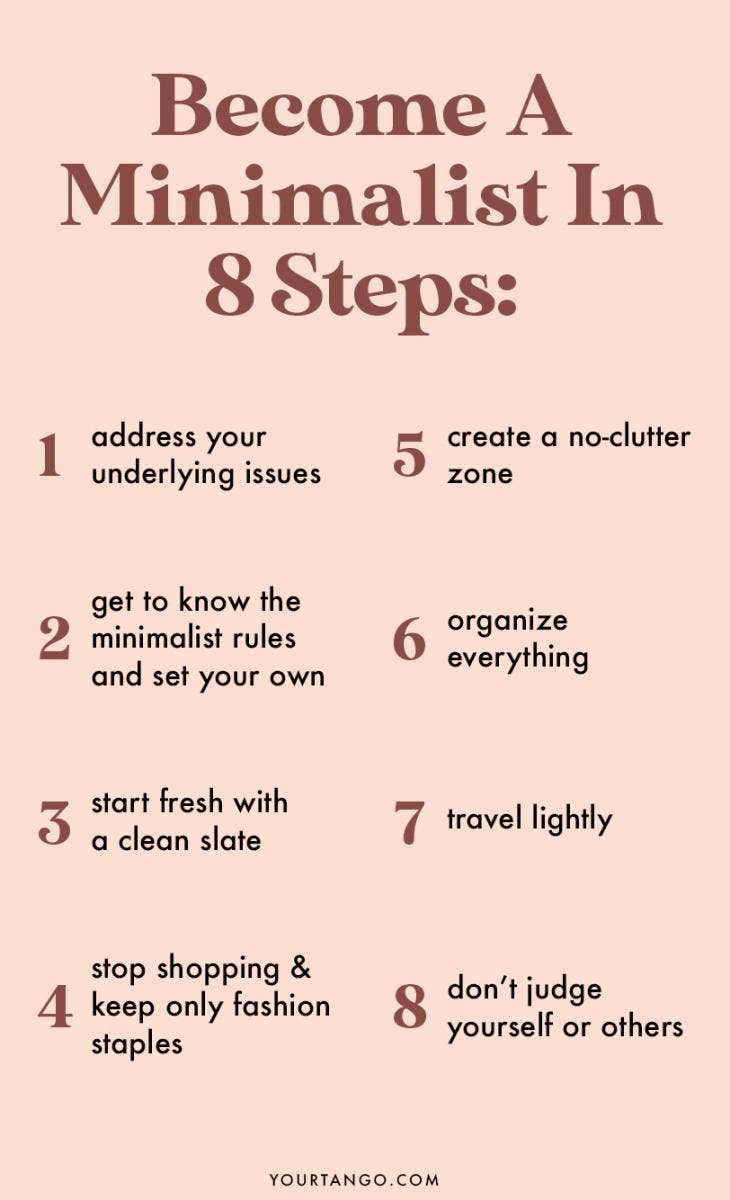8 Easy Ways To Become A Minimalist & Start Living With Less
Live a simpler life.
 Maridav / Shutterstock
Maridav / Shutterstock While our society is conditioned to believe that having things equates to happiness, materialism can actually do the exact opposite.
And if you find yourself feeling like your home, and maybe even your life, are too cluttered, you might want to look into being a minimalist.
What does it mean to be a minimalist?
A minimalist is a person whose lifestyle revolves around keeping things very simple, including their gestures, ideas, and home. Minimalists believe in the simplicity of life, and the practical view of focusing on what we really value and not what we don't need.
Minimalism is all about living with fewer material things so you can have more space for memories, and live with more heart, passion, and joy.
This lifestyle comes with its own great benefits, like a reduction in stress, less spending, and easier cleaning, as well as being good for the environment and improving productivity.
How To Become A Minimalist
If material items don't bring you joy and you are looking to change your space or routine with less "stuff" around, there are easy steps you can take to become a minimalist.
1. Address your underlying issues.
Before decluttering everything or getting rid of some of your stuff, think about why you're doing this.
It's not because you're making room for more stuff. It's because doing so frees up time, money, energy, and space for things that actually matter to you.
It's not all about "stuff" — it's about making positive changes to your life that will help you have more time and money to spend on experiences in life.
Keya Murthy, clinical hypnotherapist and spiritual life coach, suggests you be real with yourself and ask yourself serious questions: "What’s more important to you? Your loved ones, connections, conversations, good times, fun times, or cleaning, counting, dusting, tidying, keeping track of things, and to-do lists?"
2. Get to know the minimalist rules and set your own.
In order to make a positive change, you need to familiarize yourself with minimalism rules and then write down your own rules. One of the most important rules is learning all about living with intention and deciding what you'll allow into your minimalist life.
Align all the things that you have in life with what matters most to you. You get to decide your own definition of minimalism.
Make a list of reasons why you want to make this change, and then start to set goals for yourself, like decluttering and thinking about how you can make your lifestyle more simple.
3. Start fresh with a clean slate.
In order to see all the material things that you have, start with a deep cleaning of your entire apartment or house.
Separate your home into categories of things you need and things you want, and get rid of the rest, Marie Kondo style. Minimalism is all about maximizing your space, so this method is the perfect way to deep clean.
You can also get rid of any duplicate items that you don't use but just have. You can, however, keep sentimental items, but make sure it's only things you really can't live without.
According to Murthy, you shouldn't hold onto things you think you might use in the future; if you don't use them now, you probably won't any time soon.
"Things that have memories attached to them will weigh you down, will slow you down, will hold you back in life," Murthy explains. "If you want to live in light, then live light."
Of course, the tough part is deciding what's worth keeping and what you need to part with.
"To make things less stressful, box things you’re not sure about and set them aside. List the items in the box on the outside so, if you do need them, you can find them and pull them out," suggests occupational therapist Judith Pinto.
"If you never go looking for these things in the next 6 months or year, and don’t miss them, you probably don’t need them and they could be sold, donated, or gifted."
4. Stop shopping and keep only fashion staples.
You might have the urge to go shopping one last time before you start your minimalism journey. However, minimalism is about simplifying the stuff you already have. Therefore, you would be breaking your own rules if you were to go out shopping one more time.
Create a capsule wardrobe that includes one pair of perfect-fitting jeans, one pair of black trousers, one pair of sneakers, and flats. Try to keep one of everything that you actually wear so you'll get good use out of it.
Keep the quality well-made clothes that you know are going to last, and get rid of anything else you don't need or wear anymore.

5. Create a no-clutter zone.
Make sure when minimalizing your space that you start small and then grow. Don't overwhelm yourself with getting everything done at once.
According to Pinto, start towards a minimalist lifestyle the way you would make any lifestyle change: slowly, gradually, and with the easiest things first.
"If you’re super attached to your book collection, don’t begin there! Frankly, you may choose to never 'minimize' your book collection. It doesn’t have to be all or nothing," Pinto says.
Declare an area where you don't want any clutter to pile up and then start spreading that area to other parts of your home so you can gradually become more minimalist within your space.
For example, start with your kitchen table or your nightstand. Make sure it's clear and clean, and do your best to avoid letting clutter pile up there.
"You may want to start with selling, donating, or gifting items you never use, don’t like, and only keep out of some sense of obligation or 'just in case' you could use it. But don’t toss things you do need, value and use. Be realistic," adds Pinto.
Then, when you have the time, start expanding to other areas like the bathroom, living room, and eventually your bedroom.
Learning how to be a minimalist in your own home can also teach you how cleaning is actually therapeutic and helps you de-stress a bit.
"Minimalism is about spending your time (and hard-earned money) buying, maintaining, and repairing things that matter to you and add value to your life. It’s about intentional living," explains Pinto. "So think of minimalism as a way to focus on — keeping and making more space and time for — what matters and less about getting rid of things."
6. Organize everything.
With minimalism, you want to keep things simple. After you have decluttered, you want to organize your possessions.
It's important to organize by category when going through your house; that way, you're able to find duplicate items you forgot you saved and, by getting rid of them, that can help free up space.
A good rule of thumb is to keep two or three of everything. This could be a couple of towels, sheets, or pillows. Try not to have too much of one household item.
7. Travel lightly.
This is the ultimate test for a minimalist, as overpacking is something a lot of people struggle with.
Packing lighting saves you both money and time, as you won't have to worry about carrying around a heavy bag or suitcase or paying for a checked bag on a plane.
The best practice is to cut down on how much you pack. For example, if you are traveling for four days, only pack for two. That way you can just wear your clothes again or hand wash them and hang them to dry.
8. Don't judge yourself or others.
When learning to become a minimalist, don't be too hard on yourself. It's going to take time because it's a major change you're making in your life. Self-judgment isn't going to get you anywhere.
"Minimalism can be bad if you get sucked into all-or-nothing thinking and get rid of things that add purpose, meaning, and value to your life. Do it your way," suggests Pinto.
Similarly, once you have grasped the concept and started living a more minimalist lifestyle, it's not fair to judge others for not being minimalists.
Additional Tips To Become A Minimalist
One additional way to become a minimalist is to shop for quality, not quantity. You don't want to buy something you need more than one of; instead, do your research and find what is the best quality you can get.
Investing in reusable products, and being sustainable and environmentally conscious is very on-brand with minimalism. This means using reusable bags, cleaning products, food storage products, and other necessary items.
Another great way to clear up space around your home and reduce the number of items you own is by digitizing movies and books.
Megan Hatch is a former contributor to YourTango who has had bylines on Medium, Buzzfeed, MSN Canada, Patch, Voice of America, Canyon News, and others.

